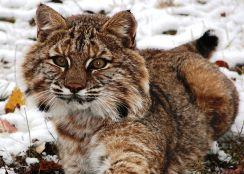 – Ohio Department of Natural Resources is studying how and why bobcats have returned to the state, by tracking 21 collared bobcats, The Madison Press reports. Previous research showed that there are two distinct populations of bobcats in the state. DNA analysis showed that the bobcats in both populations are from Pennsylvania, West Virginia and Kentucky. Read more in The Madison Press, here.
– Ohio Department of Natural Resources is studying how and why bobcats have returned to the state, by tracking 21 collared bobcats, The Madison Press reports. Previous research showed that there are two distinct populations of bobcats in the state. DNA analysis showed that the bobcats in both populations are from Pennsylvania, West Virginia and Kentucky. Read more in The Madison Press, here.
– David “Doc Quack” Riensche, an East Bay Regional Park District biologist, has been studying western pond turtles in in the eastern foothills of Mount Diablo outside Clayton, California for three years, the San Francisco Chronicle reports. The study has collected information on where the turtles winter and lay eggs. Western pond turtles are the only turtle native to California, but they face competition from non-native turtle species. Read more in the San Francisco Chronicle, here.
– Nearly 100 research volunteers surveyed the Cherokee Nation in Oklahoma for bats for this year’s “Bat Blitz,” organized by the Southeastern Bat Diversity Network, the Catoosa Times reports. One of the goals of the blitz is to document bat diversity before white nose syndrome harms bat populations in Oklahoma. Read more in the Catoosa Times.
Photo: This bobcat was in New York State. Photo courtesy NYS DEC

 The Wyoming Game and Fish Department and the Wyoming Cooperative Fish and Wildlife Research Unit recently collared 28 cow moose to add to the 65 moose they are already tracking with GPS collars,
The Wyoming Game and Fish Department and the Wyoming Cooperative Fish and Wildlife Research Unit recently collared 28 cow moose to add to the 65 moose they are already tracking with GPS collars,